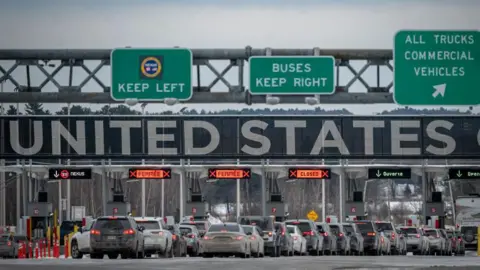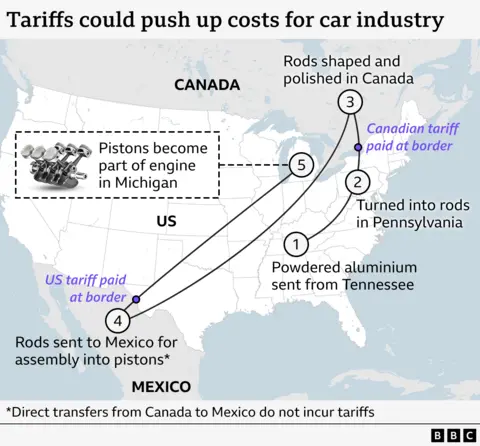Understanding Tariffs: A Deep Dive into Trump’s Trade Policies
Cars wait in line to enter the United States at a border crossing at the Canada-US border in Blackpool, Quebec, Canada, on 2 February 2025. (Getty Images)
What Are Tariffs and How Do They Work?
Tariffs are essentially taxes imposed on goods imported from other countries. When companies bring foreign products into the United States, they must pay these taxes to the government. Typically calculated as a percentage of the product’s value, tariffs can significantly affect the final price consumers pay. For instance, a 10% tariff on a $10 product would add an additional $1 to its cost. Importantly, businesses often pass these costs onto consumers, leading to higher prices in the marketplace.
Why Is Trump Using Tariffs?
Tariffs have become a cornerstone of President Donald Trump’s economic strategy. During his election campaign, he promised to implement import duties on key trade partners, arguing that these measures would bolster U.S. manufacturing, protect American jobs, and generate tax revenue. The administration also claims that tariffs are a means to hold countries like Mexico, Canada, and China accountable for issues such as illegal immigration and the trafficking of drugs like fentanyl, which is linked to numerous overdose deaths in the U.S.
How Will the Steel and Aluminum Tariffs Work?
In 2024, Canada supplied over 50% of the aluminum imported into the U.S. Following the announcement of tariffs, shares of U.S. steelmakers surged. However, American companies that rely on steel and aluminum for production warned that these tariffs could lead to increased prices for their products. The Canadian government has labeled the tariffs as "totally unjustified" and has vowed to retaliate. Historically, Trump had previously imposed tariffs of 25% on steel and 15% on aluminum in 2018, negotiating exemptions for several countries, including Canada and Mexico.
What Is Happening with Tariffs Against China?
Currently, all goods imported from China valued over $800 are subject to a 10% tariff. This includes a wide range of products, from electronics to clothing. The implications of these tariffs are significant, as they could lead to increased prices for consumers and potentially spark a broader trade war.
What Is Happening with Tariffs Against Canada and Mexico?
Initially set to begin on February 4, 2025, a proposed 25% tariff on all goods entering from Canada was delayed for a month. Canada, in turn, paused its own retaliatory tariffs on $155 billion worth of U.S. imports. Prime Minister Justin Trudeau announced a $1.3 billion border security plan aimed at curbing the flow of fentanyl into the U.S. Meanwhile, Mexican President Claudia Sheinbaum agreed to deploy 10,000 members of the National Guard to the U.S.-Mexico border to combat drug trafficking.
Which Products Will Be Affected and Will Prices Increase?
The proposed tariffs will impact a wide array of products. For example, all steel imports face a 25% tax, while goods from Mexico, such as fruits, vegetables, and spirits, could see price increases. The automotive industry is particularly vulnerable, as vehicles often consist of parts that cross the U.S., Canadian, and Mexican borders multiple times during assembly. Financial analysts predict that the average price of a U.S. car could rise by as much as $3,000 due to these tariffs.
Graphic showing how powdered aluminum from Tennessee, which ends up being used as pistons in an engine assembled in Michigan, would incur two sets of tariffs during the manufacturing process.
Will the UK and Europe Have to Pay Tariffs?
Trump has previously indicated that the UK is "out of line" regarding trade but suggested that a resolution could be reached. The UK exports pharmaceuticals, cars, and scientific instruments to the U.S., and there are calls for the UK to be excluded from tariffs due to its trade balance with the U.S. The European Commission has stated it will respond firmly to any unjustified tariffs, particularly given the significant trade deficit the U.S. has with the EU.
Economic Implications of Tariffs
The broader economic implications of these tariffs are concerning. For instance, U.S. tariffs on imported washing machines between 2018 and 2023 led to a 34% increase in prices. Experts warn that Trump’s new tariffs could trigger a wider trade war, potentially raising inflation rates significantly. Some estimates suggest that U.S. inflation could rise from 2.9% to as high as 4% as a result of these policies.
In summary, the landscape of international trade is shifting dramatically under the influence of tariffs, with far-reaching consequences for consumers, businesses, and economies worldwide. As the situation evolves, the impact of these tariffs will continue to unfold, shaping the future of global trade relations.



